Creating successful marketing campaigns and compelling content starts with understanding the numbers behind your strategies.
To me, content marketing analytics are like a behind-the-scenes guide – they show what’s working, what’s not, and where there’s room for growth.
By using data effectively, I measure the impact and success of my efforts. In this blog I will introduce you to some of the best tools that I know of for this purpose.
But I’ll start by discussing why content marketing analytics are absolutely essential.
Table of contents
What is Content Marketing?nalytics?
Content marketing analysis is the process of collecting and interpreting data related to your content marketing efforts and then using key performance indicators (KPIs) to measure the effectiveness of your campaigns.
Common metrics include page views, engagement rates, conversion rates, and organic traffic. You should measure the performance of your content across all platforms and channels. The result of your analysis will help you understand what types of content work best and how to distribute it.
The data is extremely important because you can use it as a basis for your future strategy.
Why are content marketing analytics important?
The days of simply writing a blog post, focusing on a few keywords, hitting publish, and hoping for the best are long gone.
Although ranking content on the first page of Google is still a goal for many businesses, content marketing analytics go beyond just blog posts.
Social media posts, video scripts, and email newsletters all rely on effective content to increase engagement and conversions. Even PR measures such as measuring the quality of media coverage, cost effectiveness and conversion rates are closely linked to the effectiveness of the content shared.
Content marketing analytics are important for the following reasons.
Campaign performance evaluation
Content marketing analytics provide actionable insights that enable data-driven decision making. By tracking key metrics using tools like Google Analytics, you can determine the strengths and weaknesses of your current strategy.
This includes determining what types of content resonate most, which platforms deliver the best results, and when are the ideal times to engage your audience on social media.
By analyzing metrics, I gain a deeper understanding of how my audience interacts with different types of content. To run a successful campaign, I recommend doing less and measuring more.
Measuring progress toward goals
A dashboard is a powerful tool to get data in one place and understand the analysis. With the dashboard open in front of me, I ask insightful questions like:
- Why do some key figures constantly rise or fall?
- Do certain metrics correlate by chance or is there a cause-and-effect relationship?
- Which metrics reflect actual consumer behavior?
The answers then provide a clear picture of the audience’s true preferences and actions.
Basically, content marketing analyzes make it easier to identify trends and patterns.
Help develop better strategies
Effectively using content marketing analytics to evaluate campaigns serves two main purposes:
- It allows me to develop content strategies that resonate widely with my audience.
- It helps me present more compelling pitches (something I find valuable when offering content marketing services to clients).
This data allows me to experiment and refine my approach. It also allows me to monitor performance changes and formulate effective future strategies. I recommend going through this for free Data Analysis Guide to gain more knowledge on the topic.
How to use content marketing analytics data
I tracked a client’s content marketing performance to measure its effectiveness. By analyzing key metrics, I was able to gain valuable insights that guide our content strategy.
Our strategy revolves around converting existing blog content into engaging social media posts. We started by sharing niche-relevant content on the company’s CEO’s personal LinkedIn profile. We used a content marketing tool to collect performance data.
I then organized the data into a simple Excel spreadsheet. I’m a fan of Excel because I could write down the topic of the post and relevant data at the front. This allowed me to better compare performance with other themes (see screenshots below).
This approach allowed me to see which posts resonated with the audience and which didn’t. The idea was to use this data to fine-tune our content marketing strategy to achieve better results.
I’ve broken down the process of leveraging content marketing data into three clear sections. Feel free to take inspiration from my approach, but feel free to adapt it to your needs.
Track content details
I typically update the spreadsheet with metrics about two weeks after publishing a post to ensure there is enough data to effectively analyze its performance.
I add the post URL into the spreadsheet for quick and convenient access when needed.

I also record the date and time the post was published. Tracking posting timing provides additional insight and allows me to evaluate how timing impacts engagement levels.
Tracking metrics
I document key metrics for each post, including impressions, reactions, comments, and reposts.

Whenever I notice an increase in impressions, I can easily check which topics are performing better. Remember, the idea is to use data to identify patterns and insights that will guide future content strategies.

For posts with videos, I recorded both the number of views and the total minutes of each video. The Total Engagement and Engagement Rate fields are automatically calculated in Excel. I use the following formulas:
Total number of engagements = SUM (reactions + comments + reposts)
Engagement rate = Total number of engagements/impressions
Tracking Audience Engagement
This aspect is perhaps the most powerful when it comes to getting the most out of your data. I receive the post analytics data from Signwhich looks like this:
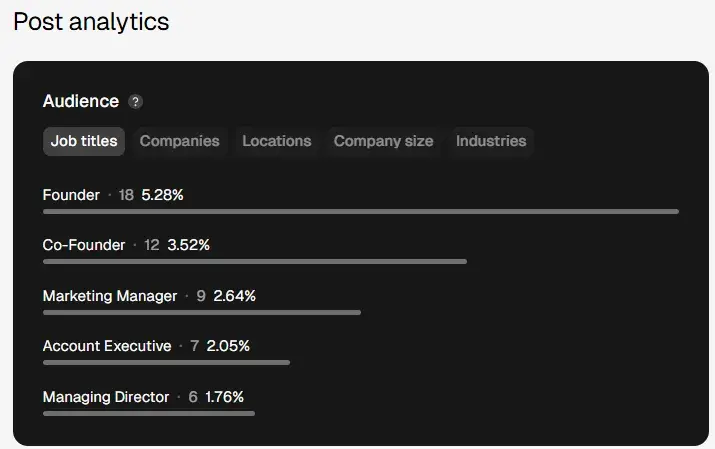
For example, when targeting individuals in marketing, I note the job titles of those who fit our target audience and have interacted with the post.
Likewise, by clicking on the “Industries” section, I can identify the sectors of those engaging with the content. If an industry belongs to our target group, I note it along with the corresponding percentage.

Note: The Shield app’s post analysis also provides data on company names, locations and company size. However, I did not include this information in the Excel spreadsheet because it was not directly relevant to our analysis.
My findings
I found this data tracking method extremely effective, not only because of its simplicity, but also because it allowed our team to provide data-driven recommendations to the client. When planning future contributions and presenting ideas, we could base our strategy on actual performance metrics.
For example, if a particular hook outperforms the previous ones, the content strategist might think of similar hooks when writing content for future posts.
Similarly, by analyzing the topics that generated the most interest, I reverse engineered the framework used for this particular post. The idea is that this data will help replicate success for future content and discard the framework or ideas that didn’t work.
If you’d rather not do all the manual data entry, check out the tools I’ve tested below.
Content marketing analysis tools
- HubSpot marketing analytics and dashboard software
- buffer
- Google Analytics
- SimilarWeb
- Semrush
- Hotjar
- Moz
- Parse.ly
- Quintly
- BuzzSumo
- Kissmetrics
- Data box
- Supermetric
- Demand sage
- Grow.com
- Plecto
- Adversity
There are numerous marketing analytics tools available with customizable metrics, a variety of visualizations and dashboards, and integrations to help you measure the impact of your marketing strategy.
Let’s dive into the best options.
1. HubSpot marketing analytics and dashboard software
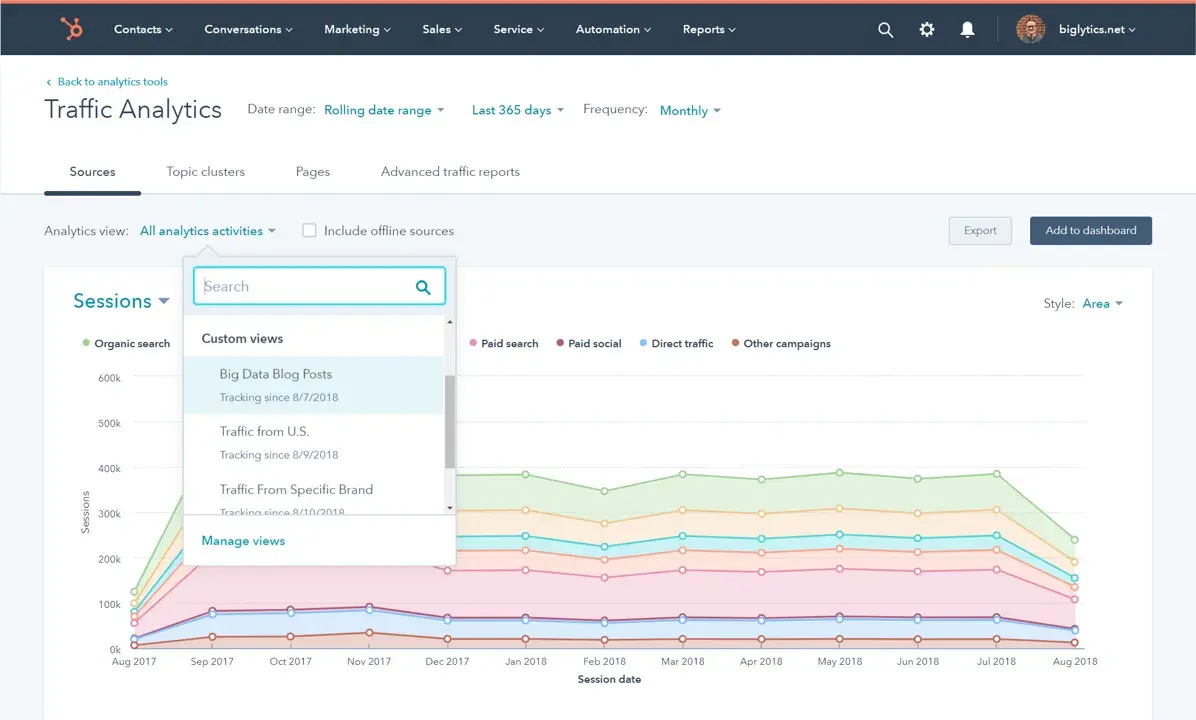
Best for: Measure the performance of all your campaigns and combine the resulting data with your CRM platform.
What I like about HubSpot’s marketing analytics and dashboard software
- Centralized insights. I love that all data and insights are accessible from one place. No more jumping back and forth between platforms; I can get the information I need in seconds.
- Custom behavior tracking. The ability to trigger or schedule touchpoints unique to my business and track interactions is game-changing. I appreciate that this conveniently highlights when a customer is ready to move on to the next phase of the buyer’s journey.
- Attribution reports. It connects every customer interaction with the associated records and revenue generated. This allows me to see exactly which efforts are paying off and which ones need to be optimized.
- Visual data dashboards. The pre-built and customizable dashboards (including Custom objects) make it easier to visualize data. Workflows allow me to quickly turn insights into actionable strategies for my segments and campaigns.
Essentially, HubSpot makes marketing analytics feel less like a chore and more like a strategic advantage.
Price
There are four Marketing Hub plans with various analytics features and flexibility, ranging in price from free (forever) to $3,600 per month.
2. buffer
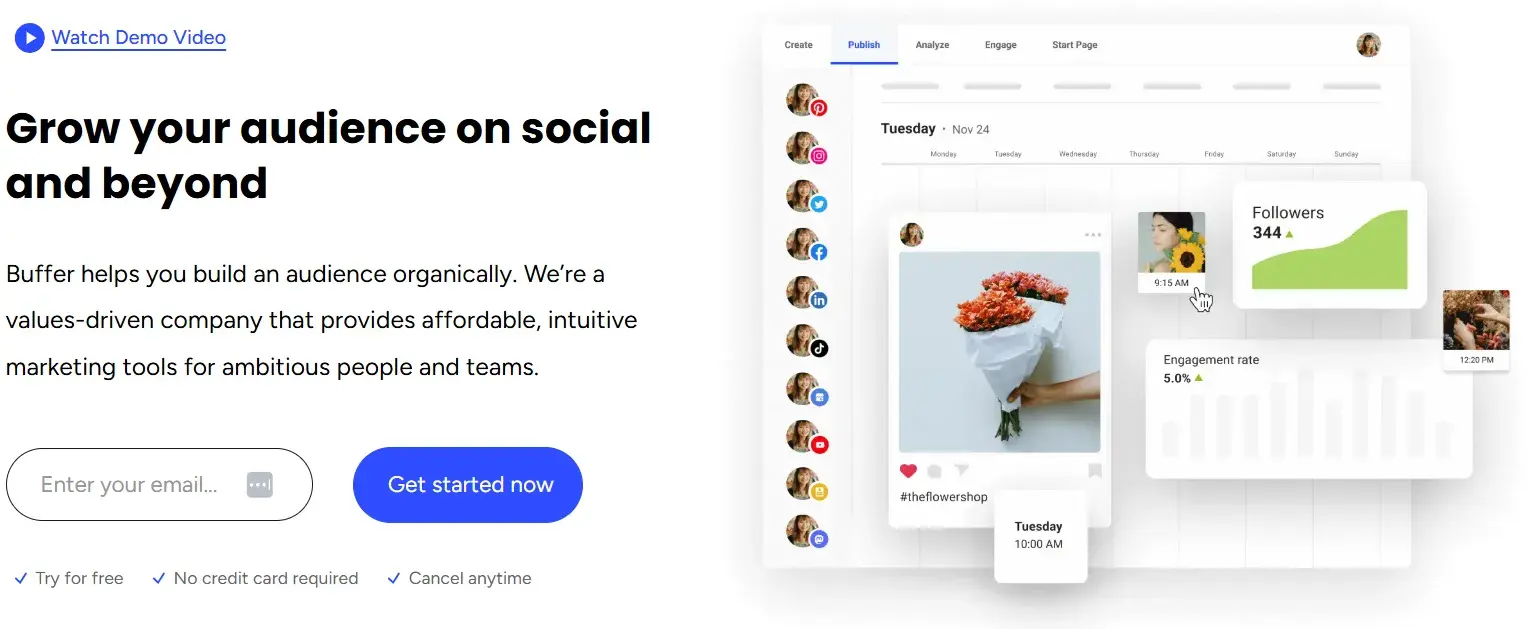
Best for: Understand channel performance in detail with customizable reports.
What I like about Buffer
Buffer is a fantastic content marketing analytics tool that allows you to dive deep into social media performance. Here are some interesting features:
- Effortless sharing. Exporting reports is a breeze – which is great, especially when it comes to regularly sharing insights with stakeholders.
- Daily updates. Knowing that the reports are updated daily gives me peace of mind that I am always working with the latest and most accurate data.
- Comprehensive dashboard. Buffer’s single dashboard view saves time. It provides a detailed breakdown of channel performance so I can quickly assess what’s working and what needs adjustment.
- Engagement insights. The platform provides engagement metrics for each social account individually. This helps understand how customers interact with posts, stories, and hashtags and how audience demographics differ between channels.
- Social media management. I like how this app brings together all social media platforms in one place. This makes posting very effective.
Price
Buffer’s Marketing Analytics product offers three payment options with different features and flexibilities.
- Free
- Essentials – $5/month
- Teams – $10/month
3. Google Analytics
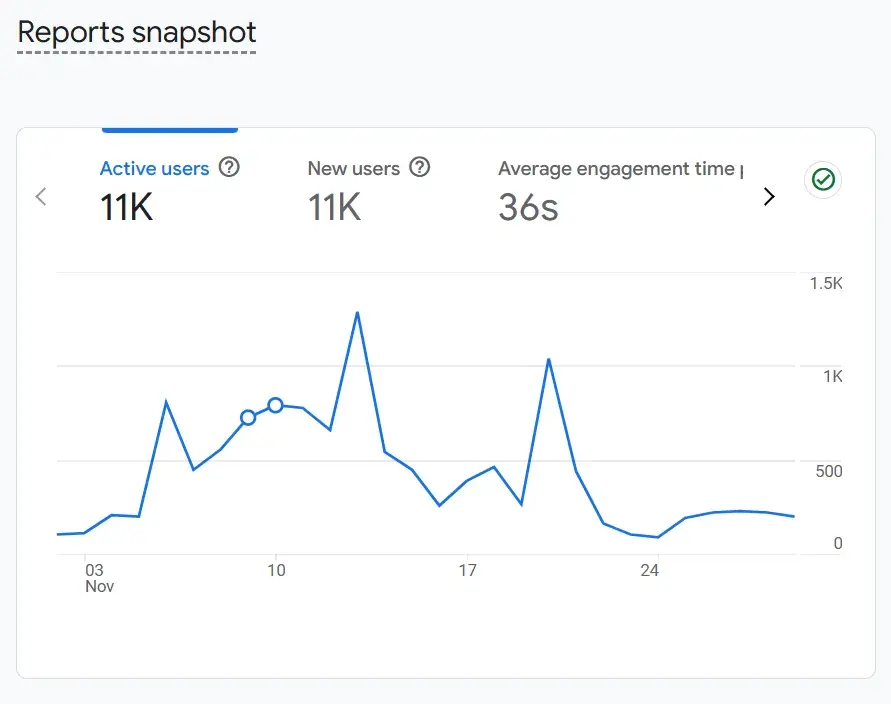
Best for: Seamlessly integrate content marketing analytics with other Google business tools and make data-driven strategic decisions.
What I like about Google Analytics
Here’s what I like about Google Analytics:
- Intuitive user interface. Navigating Google Analytics is straightforward, even for beginners. It is intended to help you quickly understand how content works across multiple platforms.
- Granular analysis options. I love that I can analyze the performance of my content either across my site or on individual pages. This flexibility allows you to pinpoint which areas need improvement.
- Comprehensive metrics. The tool provides a wealth of data on traffic, navigation patterns, conversions, and organic search performance.
- User-level insights. Allows tracking of user-level interactions, giving me a clear picture of how audiences are engaging with my content.
- Seamless integration. Integration with other Google business tools is a big plus. It’s incredibly convenient to access all of my data and insights without having to switch between platforms.
Price
Google Analytics offers a free and a paid plan. The free plan is ideal for SMBs and you can start using it immediately. The paid plan called Analytics 360, on the other hand, is ideal for enterprise-level businesses and requires you to speak to a sales representative to get a quote.
4. SimilarWeb
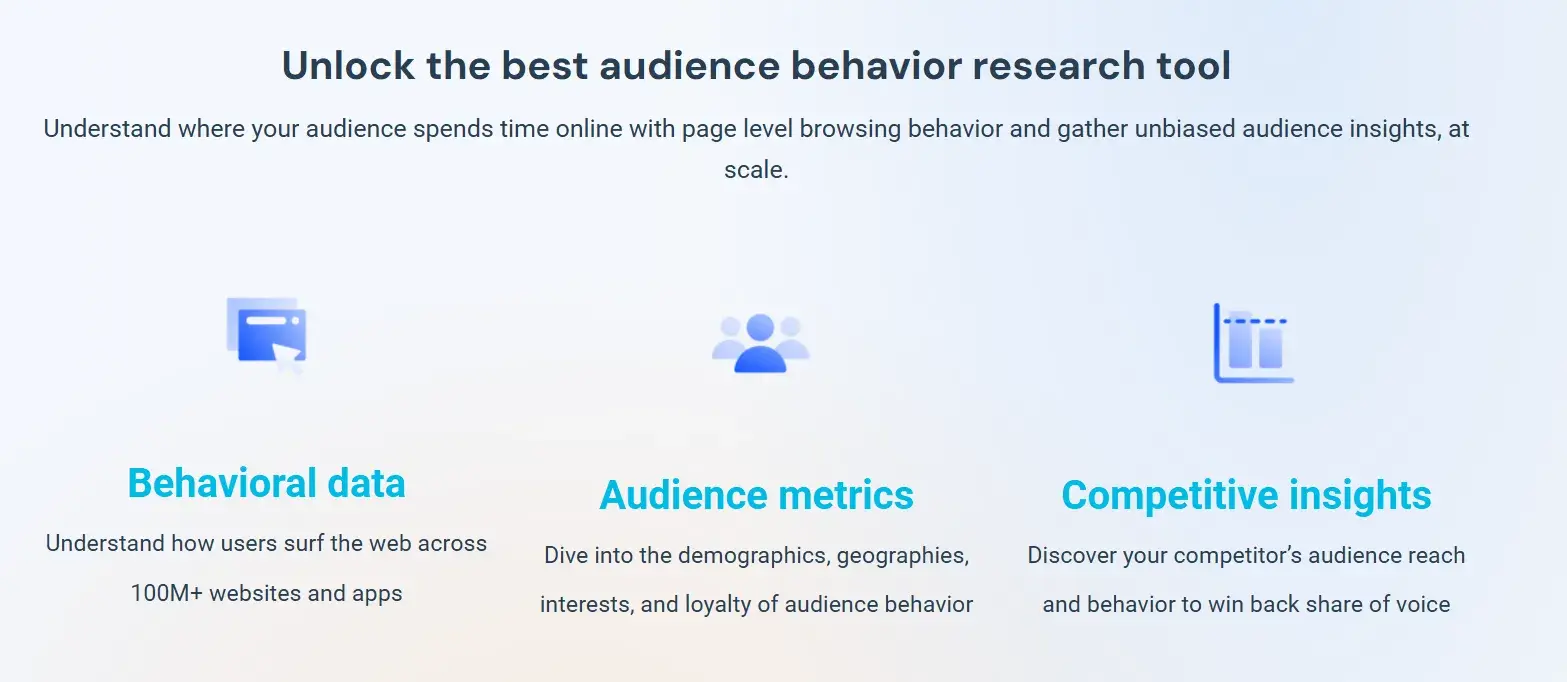
Best for: Understand where your website and content strategy stack up against industry standards.
What I like about SimilarWeb
SimilarWeb offers the following benefits:
- Competitive insights. Provides detailed traffic and engagement metrics that show exactly where my website stands compared to others in my industry. It is invaluable for assessing performance and identifying areas for improvement.
- Comprehensive metrics. Provides key metrics such as daily active users, sessions per user, usage time, and rank. It also helps to find out more about the audience, such as their repetitive behaviors and interests.
Price
- Starter – $199/month
- Professional – $449/month
5. Semrush
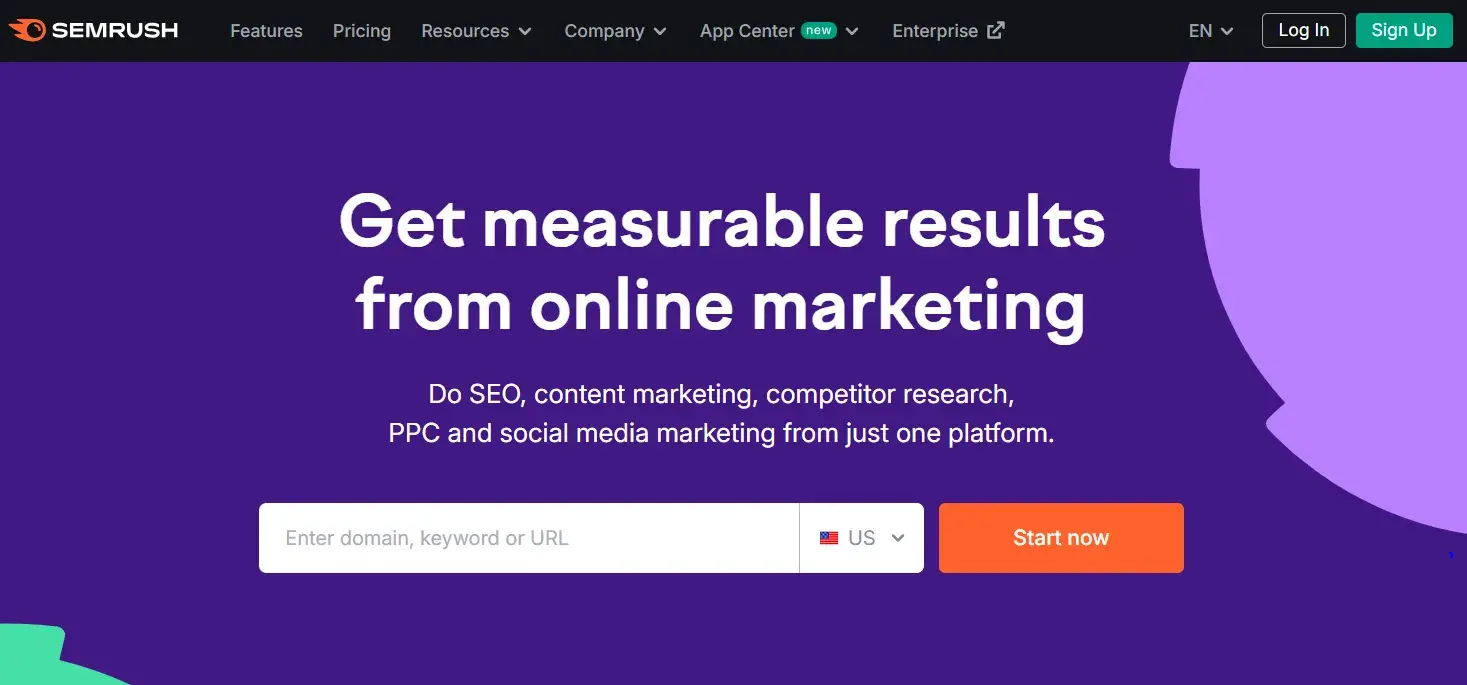
Best for: Track the SEO and keyword performance of your websites and content strategy.
What I like about SEMrush
Semrush is an essential tool for managing and improving SEO strategy. This is what makes it so effective:
- Keyword ideas. When I search for a search term in SEMrush, I am presented with options for many secondary keywords that I didn’t initially think of. These options tend to be low-hanging fruit and are perfect for staying ahead in search rankings.
- Domain overview. Essentially, I can get information about any competitor by simply adding the website domain. It provides insights into organic search traffic, top performing keywords, and even backlink profiles.
- Content gap analysis. One of my favorite features is the “Keyword Gap” feature, which allows me to compare the website I’m analyzing with the competition to see what keywords they rank for, as opposed to that particular website. I also do the same for backlinks by using the Backlink Gap feature.
Price
Semrush offers three plans, ranging in price from $119 to $449 per month.
6. Hotjar
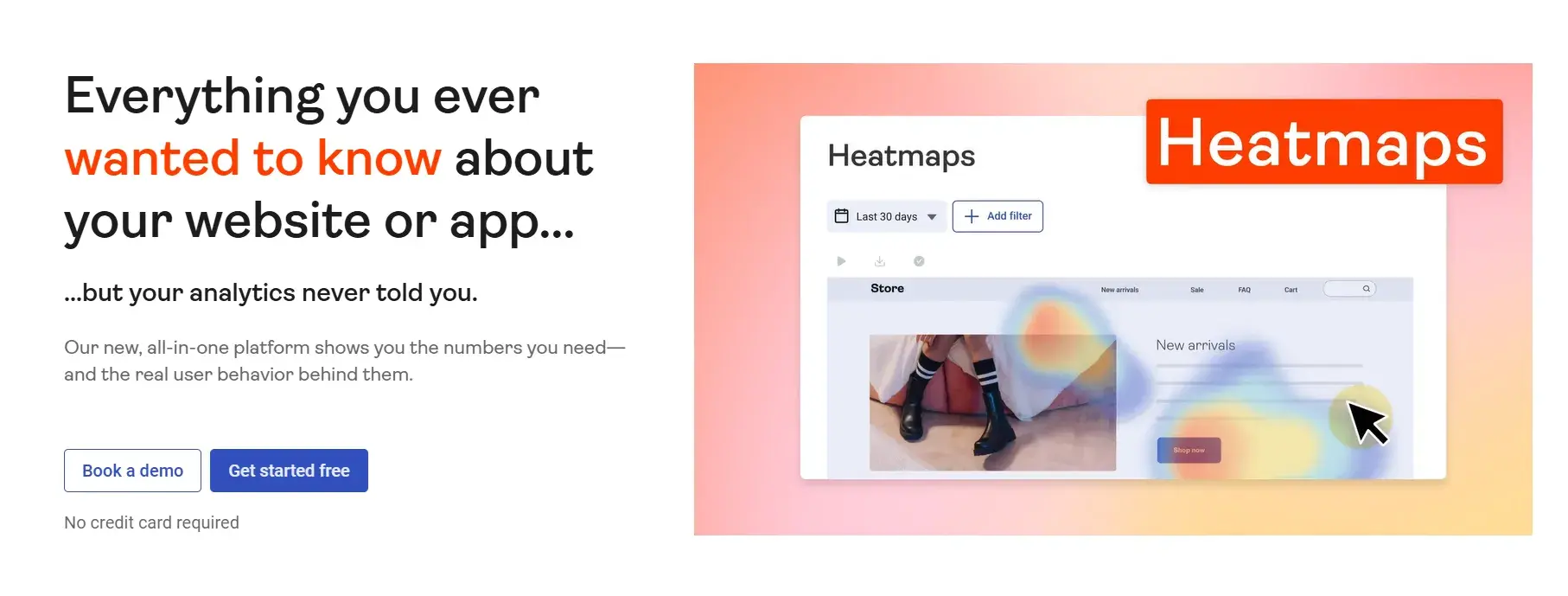
Best for: Track and visualize sessions on websites with heatmaps.
What I like about Hotjar
Hotjar is an incredible tool for understanding how visitors interact with my website. Here’s why I think it’s worth using:
- Heat maps. I love that Heat maps Feature – it shows me visually exactly where customers are spending their time on the website. I can easily identify the most interesting content and areas that need improvement.
- Meeting recordings. The real-time videos are a game-changer. By observing how visitors navigate the site, I gain deep insights into their behavior and know what catches their attention.
- Conversion tracking. It’s easy to track conversions and identify patterns in the buyer’s journey. I can quickly see which stages customers may be entering or exiting, allowing me to optimize the journey and achieve better results.
Price
- Free
- Plus – $39/month
- Business – $99/month
- Scale – $213/month
All of these prices go down slightly if you choose the annual billing option.
7. Moz
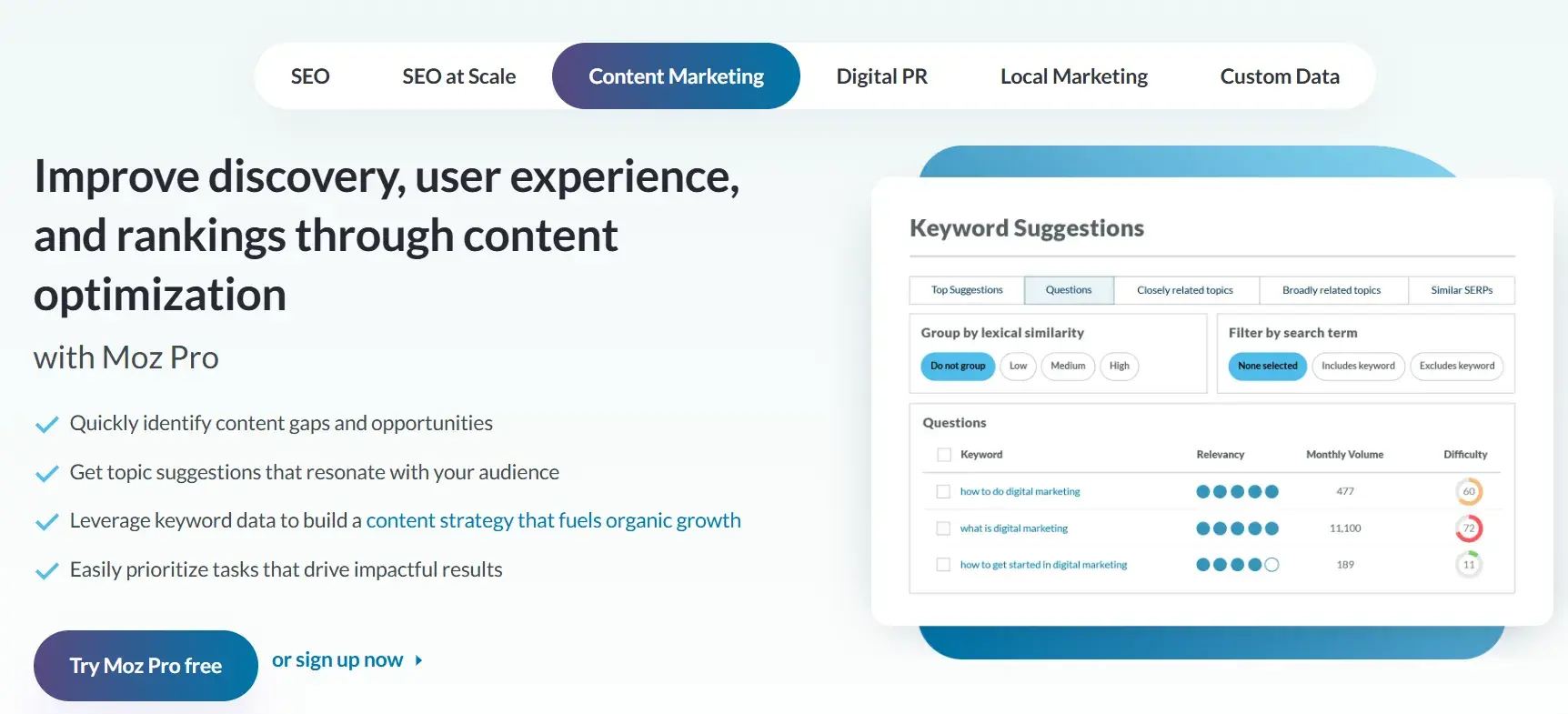
Best for: Measure your SEO content strategy and determine which keywords you should use.
What I like about Moz
Moz is my favorite tool for optimizing SEO content strategy. What’s special about it:
- Keyword insights. Moz gives me a clear overview of which keywords are the most effective.
- Rank tracking. I like how Moz tracks a website’s keyword rank and visibility over time. It shows what’s working and what needs improvement – helping you make informed adjustments.
- Competitive analysis. Similar to SEMrush, Moz offers the ability to track how competitors are ranking in the SERPs. This is a great way to identify opportunities for improvement and find gaps in content.
- Detailed reporting. Moz’s reports are incredibly thorough. They show how my content is performing, communicate well that I’m reaching my audience, and provide actionable recommendations to improve results.
Price
- Local – $14/month
- Pro – $99/month
- Stats – $720/month
8. Parse.ly
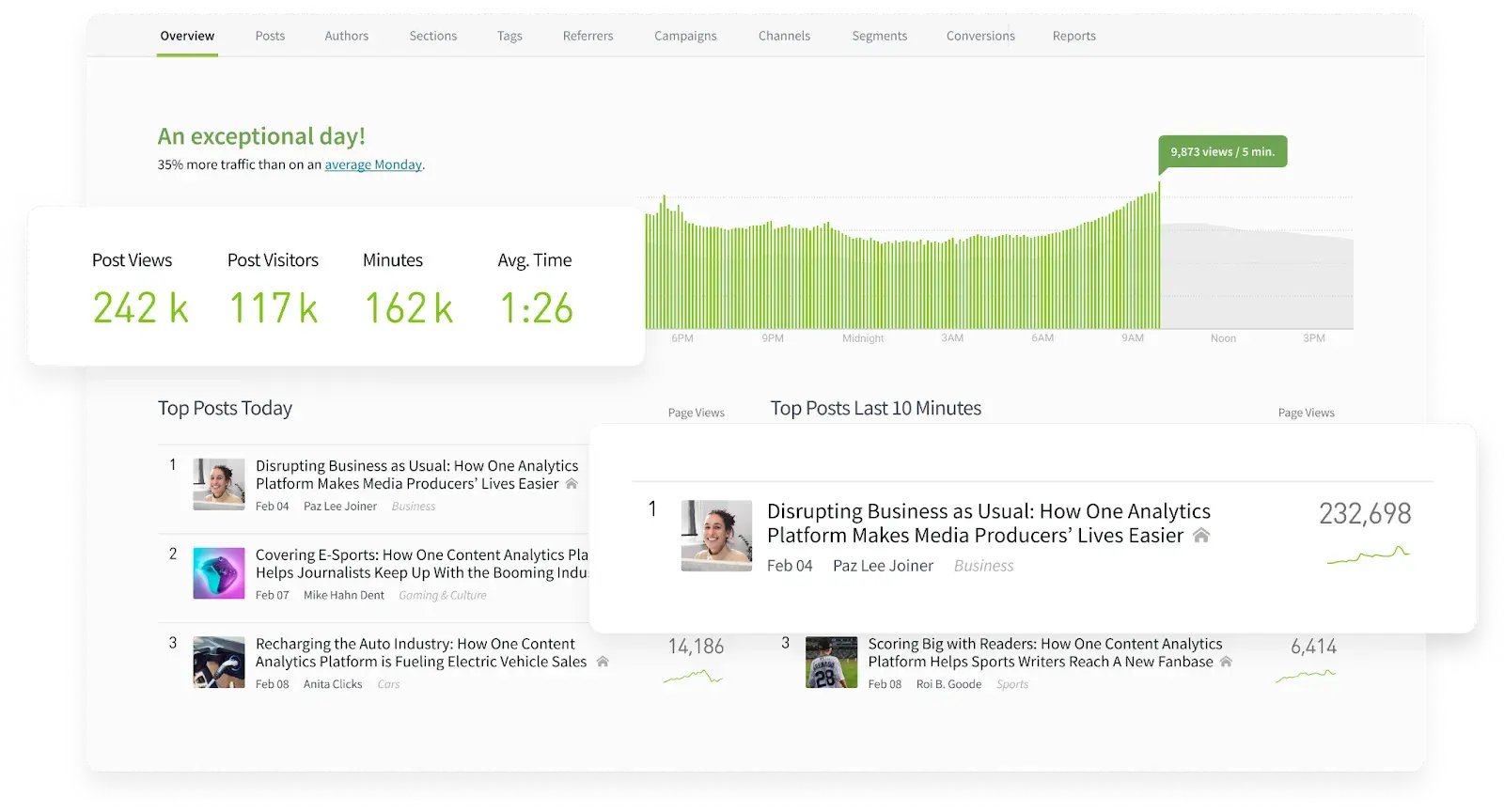
Best for: Make it easy for the entire team to understand how content drives business.
What I like about Parse.ly
Parse.ly is a fantastic tool for content-driven teams, and I would recommend it for the following reasons:
- User-friendly for everyone. Unlike more complex platforms, Parse.ly is designed to be accessible to everyone on the team, even those who are not data experts.
- Clear content insights. Parse.ly simplifies data and focuses on what matters – showing how content drives traffic, conversions and overall ROI. It makes proving the value of my efforts a breeze.
- Optimized distribution. The tool helps me optimize the way I distribute content across all channels and ensure it reaches the right audience in the most effective way.
Parse.ly makes it easier to understand and respond to content performance, empowering teams to develop strategies that drive real business results.
Price
Parse.ly asks potential buyers to book a demo to receive a customized quote and choose the right plan for their business.
9. Quintly
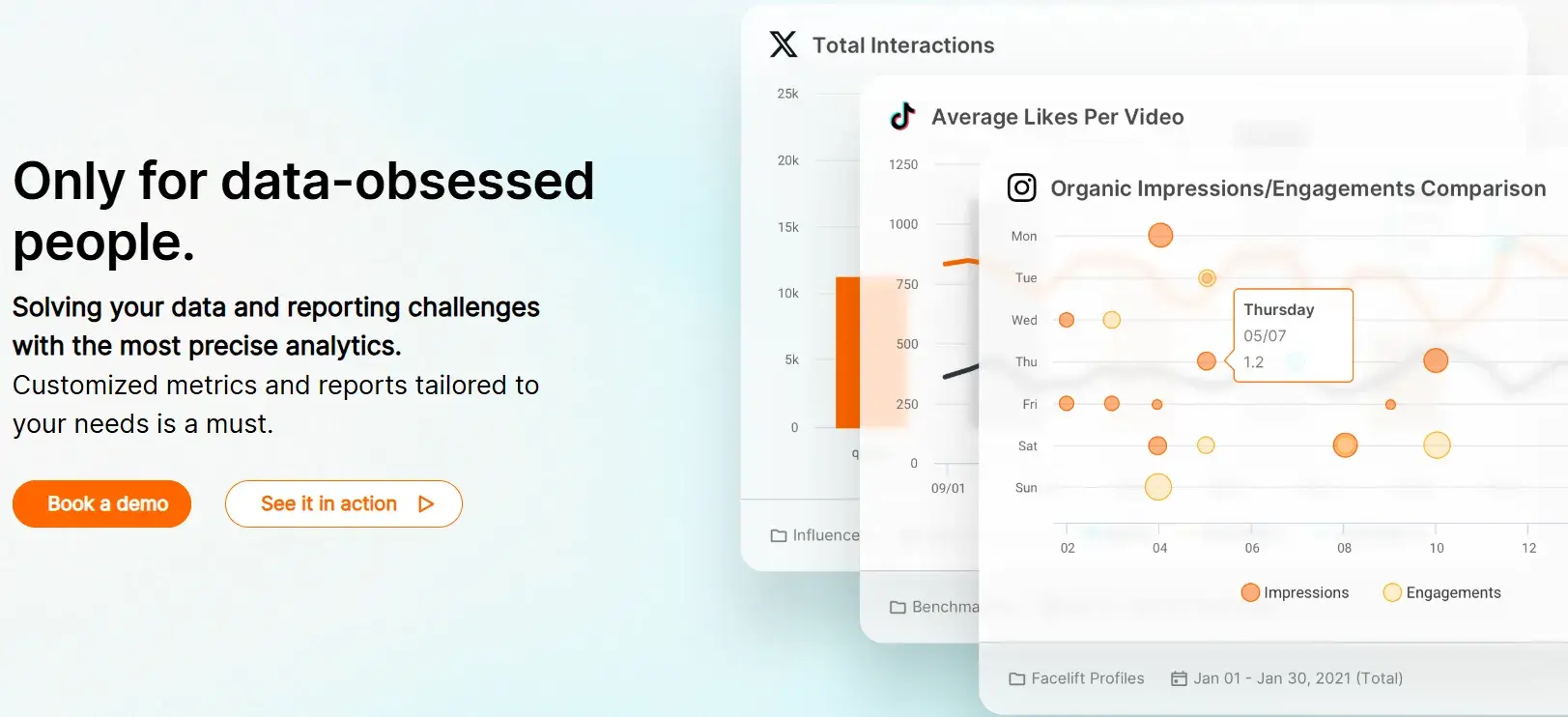
Best for: Improve social planning by analyzing the success of your social media marketing strategy with customizable metrics.
What I like about Quintly
Quintly is a powerful tool for taking social media marketing strategies to the next level. Here’s why it stands out for me:
- Customizable metrics. I love that Quintly allows me to customize metrics that align with my specific goals. It is invaluable for analyzing campaigns and making smarter social planning decisions.
- Automated reports. Quintly’s automation feature saves a lot of time. It generates reports and measures their impact using a machine learning system, making data analysis seamless.
- API integration. With API access and integration with tools like Google Search, Quintly helps break down data silos and provide a holistic view of performance.
Price
Quintly pricing is available upon request.
10. BuzzSumo
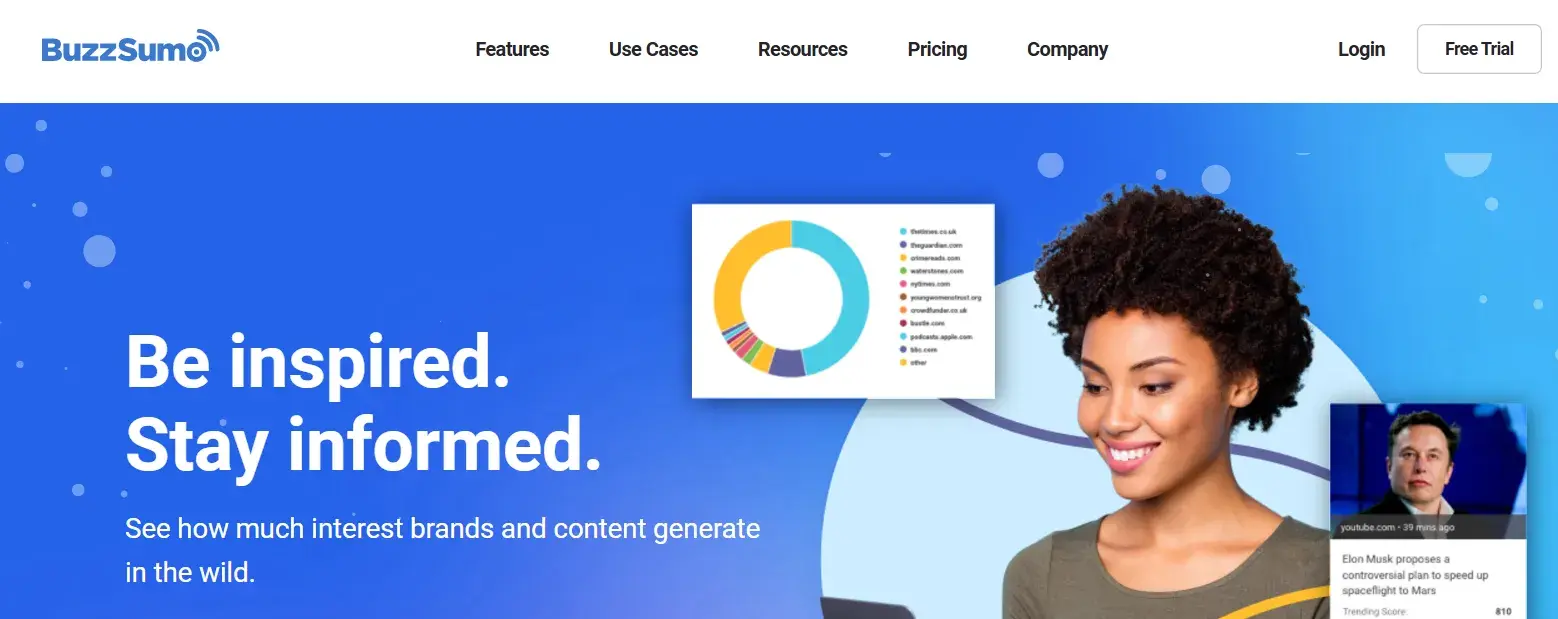
Best for: Visualize and analyze marketing trends in real time to tailor content to your target audience.
What I like about BuzzSumo
BuzzSumo is my tool of choice for staying on top of marketing trends. That’s why I find it so valuable:
- Real-time trend analysis. I love the way BuzzSumo allows me to view and analyze real-time marketing trends. It helps me stay ahead by identifying what is likely to resonate with my audience at the moment.
- Location-related trends. The ability to filter trends by location is incredibly useful. It helps understand what is popular in different regions and makes my content more tailored and relevant.
- Customizable feed. A tailored feed allows me to stand out from the crowd and focus on the data that matters most to my strategy.
- Content inspiration. The tool shows successful content examples and makes it easy to spot proven strategies and identify relevant keywords to include in campaigns.
Price
- Content Creation – $199/month
- PR and Communications – $299/month
- Suite – $499/month
- Enterprise – $999/month
11. Kissmetrics
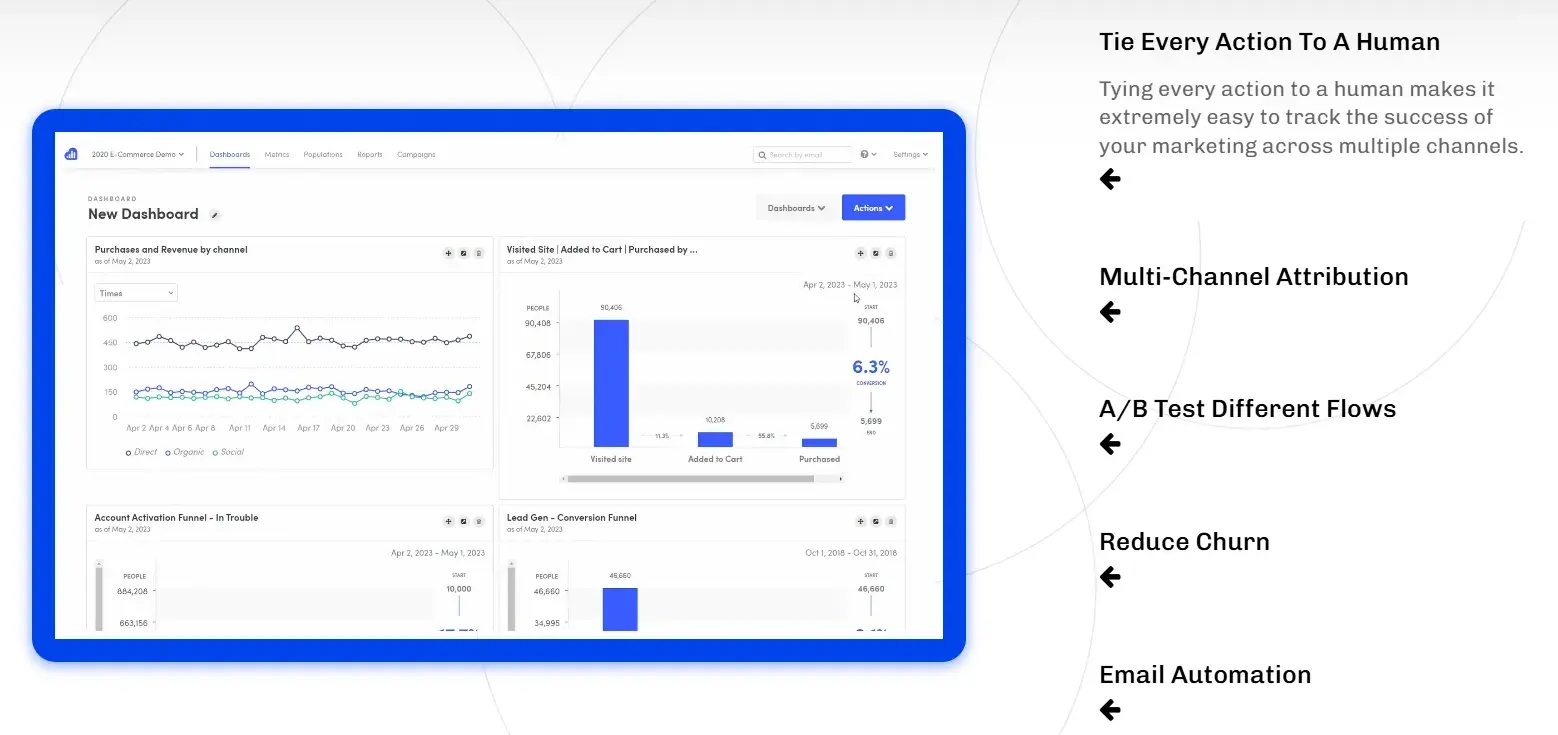
Best for: Discover how your audience interacts with your website/apps and understand their behavior.
What I like about Kissmetrics
That’s why I recommend you try the tool:
- Travel tracking. I love how Kissmetrics allows me to track a customer’s journey across multiple devices. This gives me a complete picture of how they interact with my website and apps.
- Behavioral insights. Provides deep insight into how customers interact with content and provides valuable insight into what resonates most with them.
- Conversion metrics. Provides detailed conversion metrics such as bounce rate and time on site.
Kissmetrics is perfect for refining content strategies and improving user engagement by understanding what really matters to your audience.
Price
The SaaS plan includes four payment options: These plans cost $299, $499, or an individual price (based on your individual plan).
12. Data box
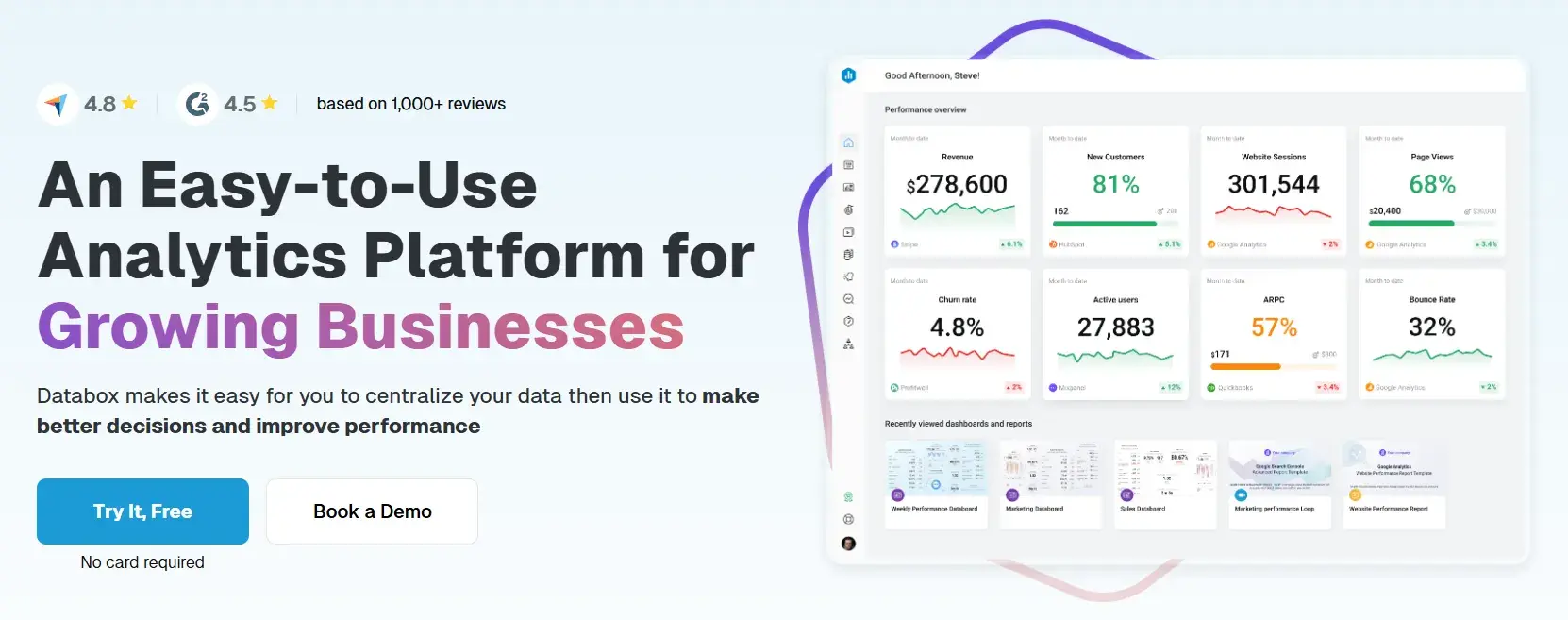
Best for: Combine all your marketing data to track and understand the success of your strategy in a single place and in real time.
What I like about Databox
I recommend Data box for anyone who wants a centralized way to track their marketing performance. I think it’s a great tool for the following reasons:
- All-in-one dashboard. Simplifies performance tracking by organizing all business data in a single place.
- Extensive integrations. It offers over 70 integrations to incorporate data, display it visually, and share insights seamlessly.
- Target tracking. The SMART Goals feature is one of my personal favorites. This allows you to track your progress toward specific goals, helping you stay on top of your goals.
- Scorecards and notifications. The tool sends daily, weekly or monthly updates on your KPIs. Additionally, real-time alerts ensure you can respond quickly to irregularities in your data.
Price
- Free forever
- Starter – $59/month
- Professional – $199/month
- Growth – $399/month
13. Supermetric
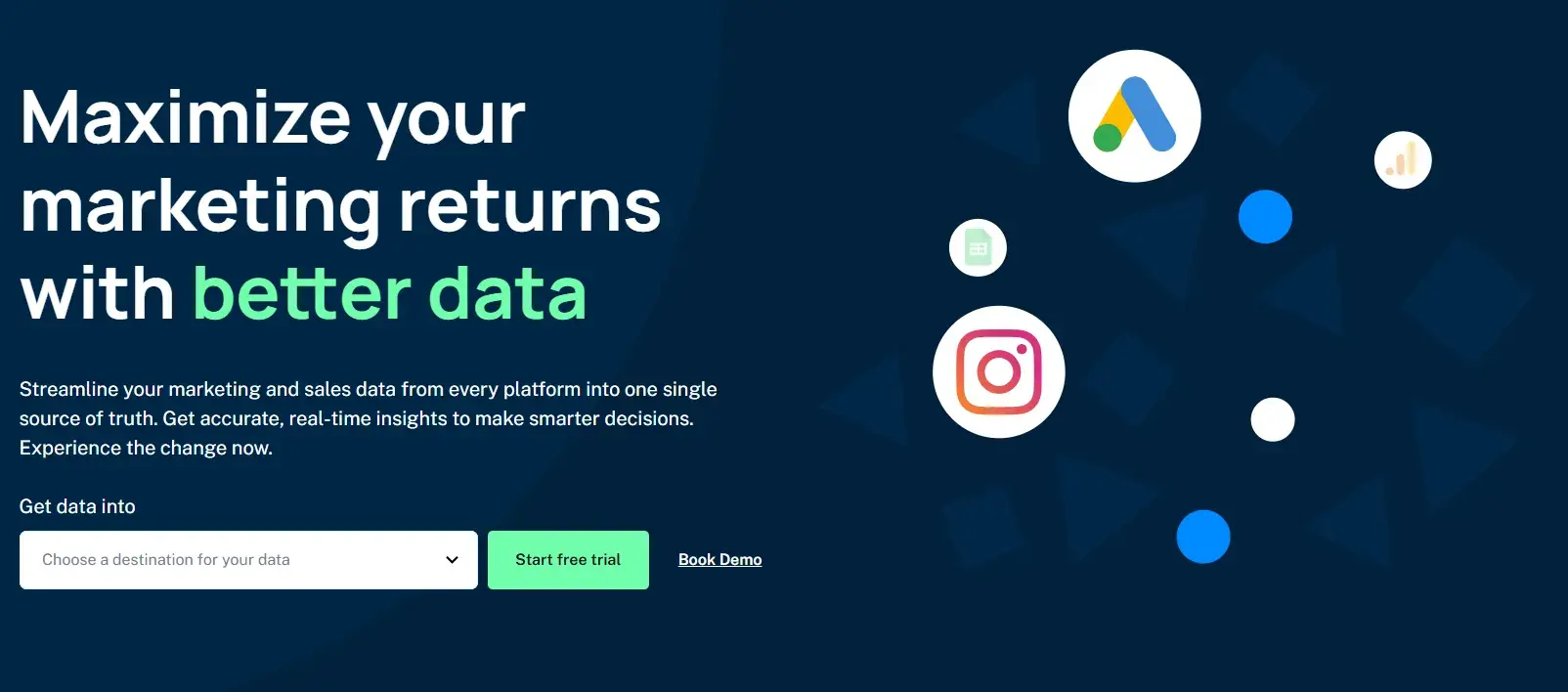
Best for: Take marketing data from any source and move it to Google Sheets, Google Data Studio, Microsoft Excel, Google BigQuery, or Snowflake for analysis.
What I like about Supermetrics
If you’re looking for a powerful way to centralize and analyze your marketing data, Supermetric is a fantastic choice. Here’s why:
- Data integration from any source. Simplifies the process of getting data from various sources such as SEO, PPC, social media and web analytics tools.
- Robust reporting and analysis. Serves as a complete solution for reporting, analytics, and data storage – especially invaluable for marketers focused on performance metrics.
- Versatile export options. Easily move data into platforms such as Google Sheets, Google Data Studio, Microsoft Excel, Google BigQuery or Snowflake for further analysis.
- HubSpot integration. The Integration with HubSpot is an excellent bonus, especially if you already use HubSpot for your marketing efforts.
Price
Supermetrics and HubSpot integration: Business Performance Tracking
Supermetrics has multiple products, so prices vary depending on the product you choose. For example, if you want to move your data across Google Sheets, Microsoft Excel, Looker Studio, and Power BI, the starting price is $29/month.
If you want to get the Supermetrics API or use Snowflake, Azure, BigQuery, or Google Cloud Storage, you will be asked to fill out a form to request pricing.
14. Demand sage
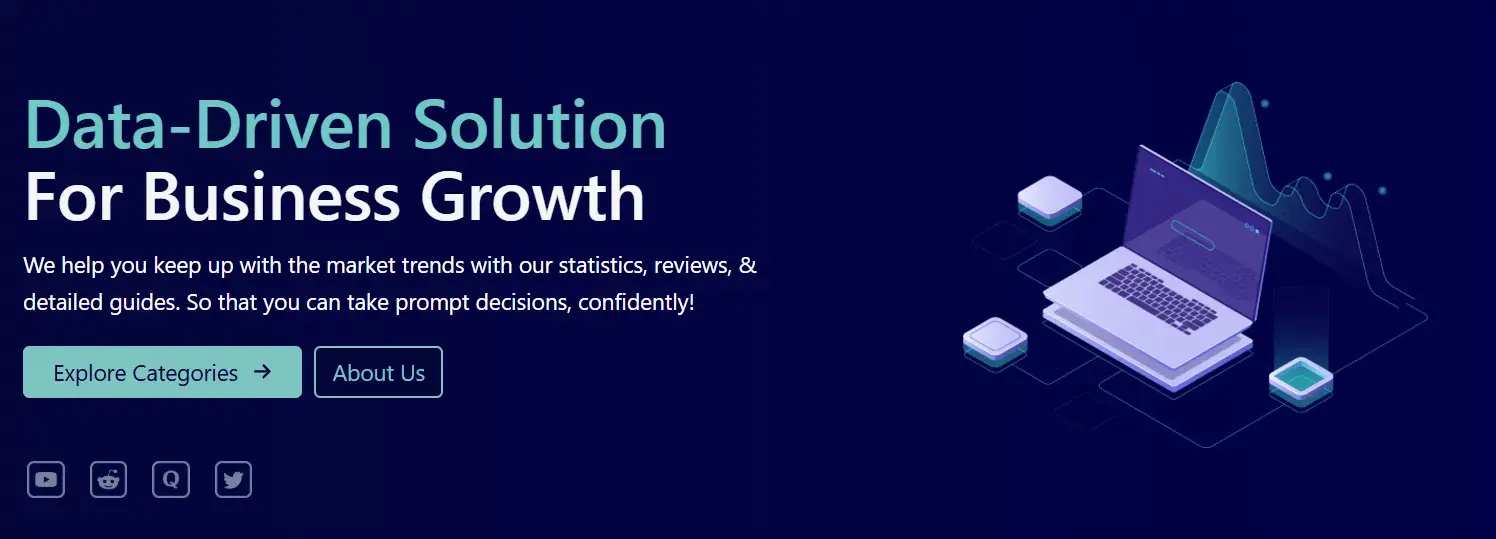
Best for: Move all your HubSpot data into Google Sheets for easy analysis on your platform of choice.
What I like about Demand Sage
This is what makes Demand Sage so helpful:
- Seamless data synchronization. With just one click, Demand Sage pulls all your HubSpot data into Google Sheets. It’s fast, efficient and hassle-free.
- Customizable reporting. I love the flexibility of one-click customizable reports that highlight key insights into marketing and sales performance.
- Granular analysis. With table builder and record-level reporting, you can create highly detailed views tailored to your specific needs directly in your table.
- Attribution and revenue insights. Demand Sage connects marketing and sales data in meaningful ways. It provides a clear overview of pipeline performance and revenue drivers.
If you use HubSpot and need an intuitive way to analyze your data in Google Sheets, Demand sage is child’s play.
Price
Demand Sage’s basic plan is free. When I looked at the premium plan, I was prompted to contact a sales representative for more information.
15. Grow.com
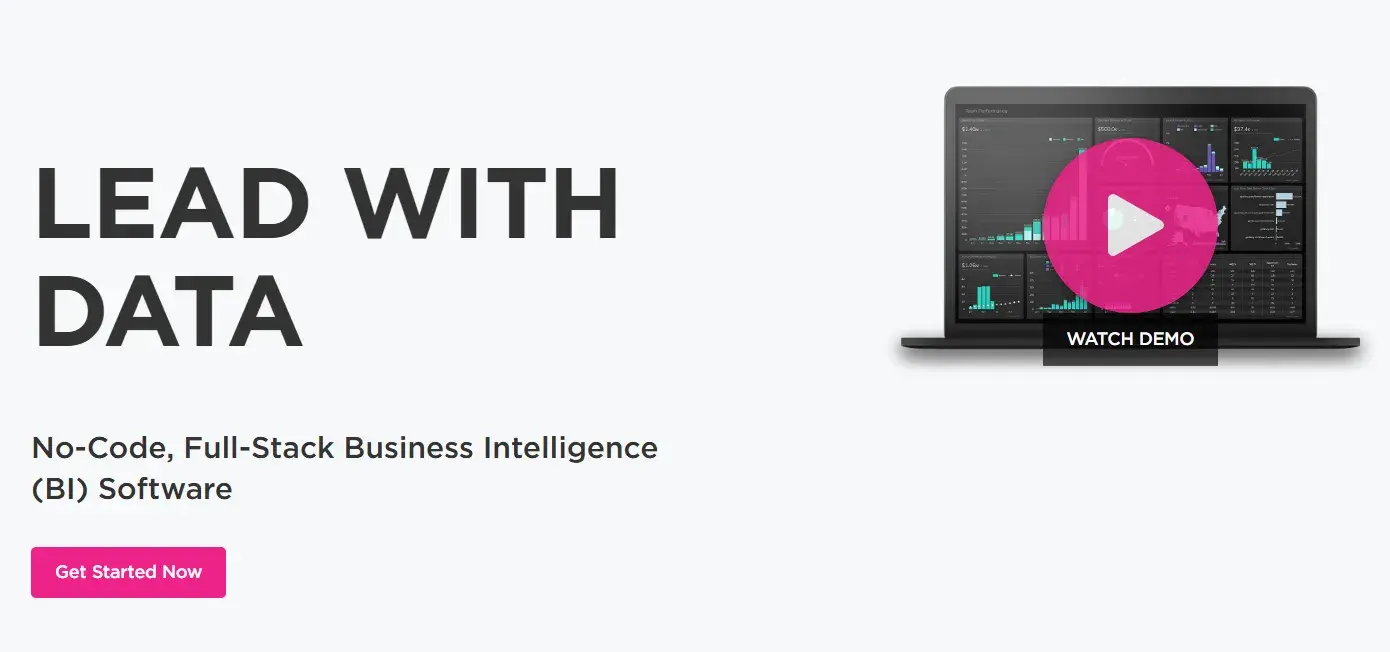
Best for: Import and transform business data from various sources and then combine that data into custom dashboards.
What I like about Grow.com
- Flexibility in data visualization. I can choose from a variety of chart types to visualize my data in the way that makes the most sense for me and my team. This flexibility ensures that we have a clear overview of our performance at all times.
- Collaborative sharing. The ability to share metrics and dashboards with my team ensures everyone knows where to focus their efforts – something that is critical to achieving results.
Price
Get a free Grow.com demo and speak to a representative about pricing the right plan for your business.
16. Plecto
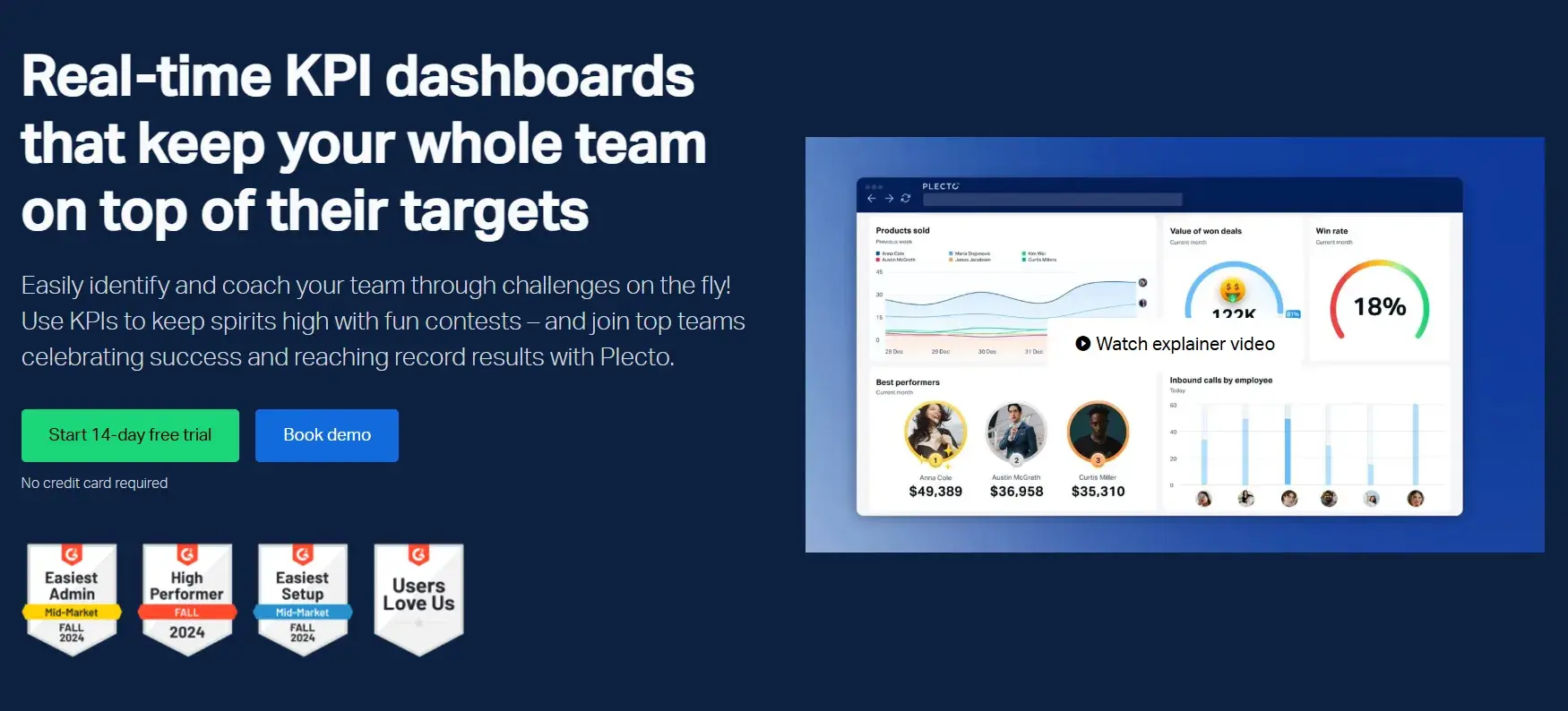
Best for: Keep your team informed about goals and objectives with dashboard data visualization software.
What I like about Plecto
Plecto is an excellent tool for keeping your team focused and aligned. That’s why I recommend it:
- Real-time data insights. I really appreciate how Plecto incorporates data from an unlimited number of sources and provides real-time insights that help me stay on top of my goals and track progress seamlessly.
- Customizable dashboards. Ability to filter by different sources and customize the dashboard to show the metrics that are most important to me.
- Gamification for motivation. Plecto’s gamification features are fantastic for increasing team engagement. Adding friendly competition can serve as motivation for the team to stay focused on goals and achieve goals faster.
- Target-oriented visuals. The ability to view goal tracking data on interactive dashboards makes it easy for everyone to see where we stand and what needs more attention.
Price
Plecto offers three payment options depending on which plan you choose:
- Medium – $230
- Large – $355
- Enterprise – Custom
The price is reduced if you choose the annual billing option.
17. Adversity
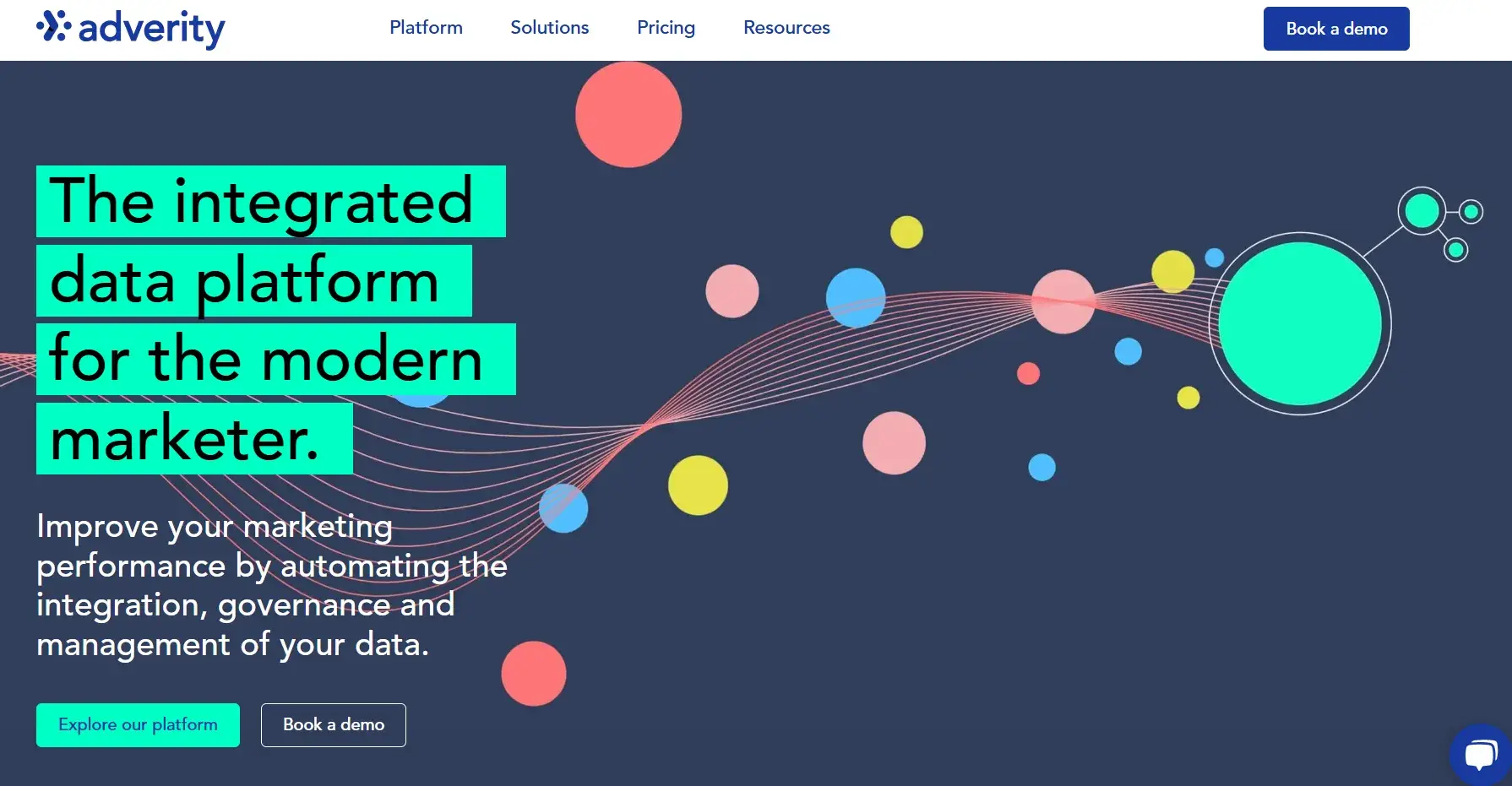
Best for: Automate data integration from hundreds of sources.
What I like about Adverity
Adverity is a popular marketing data analysis tool for the following reasons:
- Eliminates data silos. It helps break down data silos by centralizing marketing data and making it accessible to everyone on my team. This ensures that we all use the same information when making decisions.
- Augmented analytics based on AI. Adverity’s use of AI to identify trends and insights is groundbreaking. It quickly identifies areas for improvement and highlights strengths so I can focus on the right actions to achieve results.
- Time-saving reports and visualizations. With its automated reporting and data visualization capabilities, Adverity eliminates manual work so I can easily generate and share detailed insights.
If you want to optimize your marketing data processes and make smarter, data-driven decisions, Adverity is definitely a tool worth considering.
Price
The idea of Adverity is that they don’t stick to rigid pricing plans. Since prices are different for each customer, you will be asked to fill out a form to receive a customized quote.
Content Performance: What I think you should focus on
When measuring the performance of your content, I recommend the following steps:
- Decide which one Performance indicators you will measure.
- Track these metrics and KPIs.
- Analyze and apply your findings.
Content performance indicators
Because there are so many performance indicators, I focus on identifying which ones are most important to my goals. Here is a list of indicators to choose from:
- Web traffic. The amount of traffic you receive on your website and individual pages.
- Page views. The number of times a website is viewed by visitors.
- Impressions. The number of times an ad or web page is shown to a person.
- meetings. A group of actions that an individual website visitor takes on a website during a specific period of time.
- Bounce rate. The percentage of visitors who visit your website but don’t convert in any way – in fact, they leave your website before taking any action.
- Search Engine Optimization (SEO). Keyword and search engine results page (SERP) success and performance.
- Engagement. The number of interactions your visitors have with your content (e.g. comments, shares, likes, forwards, subscriptions) and how long the interaction lasts on these channels and websites.
- Social media engagement and interactions. Depending on your social media platforms, there are specific metrics for this Engagement and interactions to a post and/or content that you can analyze (views, shares, comments, likes, etc.).
- Lead generation and conversions. The number of leads acquired, conversions and sales resulting from your content (e.g. email signups, blog subscriptions, CTA clicks, downloads and product purchases).
- Brand awareness. This reflects how your audience discovers your brand, gains insights into your products, understands your mission, and connects with what you stand for.
To truly measure brand awareness, I suggest taking a look at other metrics on this list, such as: B. Page views, social media engagement (or simply the process of social listening), downloads, video views, referrals and resources/documents read or shared.
- Customer loyalty. The amount of content your current customers consume and/or interact with (e.g. if a current customer is a blog subscriber who receives weekly articles in their email inbox).
- Upselling/Cross selling. Sales for new, additional or improved products you offer.
Apply content marketing analytics to grow better
I believe content marketing analysis tools are essential for refining and optimizing your content strategy.
They can help your team understand the health of your strategy, audience behavior, interactions, and progress toward your goals.
This gives you the information you need to improve customer experience, resonate with your audience, and increase conversions.
I recommend you make sure the content you create provides real value.
Refine your SEO strategy with tools like Moz and SEMrush. Analyze customer interaction with tools like Buffer and Hotjar. Create dashboards to view your metrics and workflows and automate manual tasks with HubSpot.
The idea is not just to collect data but to transform it into actionable insights that can lead to better decision making and tangible results. Use these tools to refine your approach and improve the customer experience.
Editor’s Note: This post was originally published in June 2020 and has been updated for completeness.


